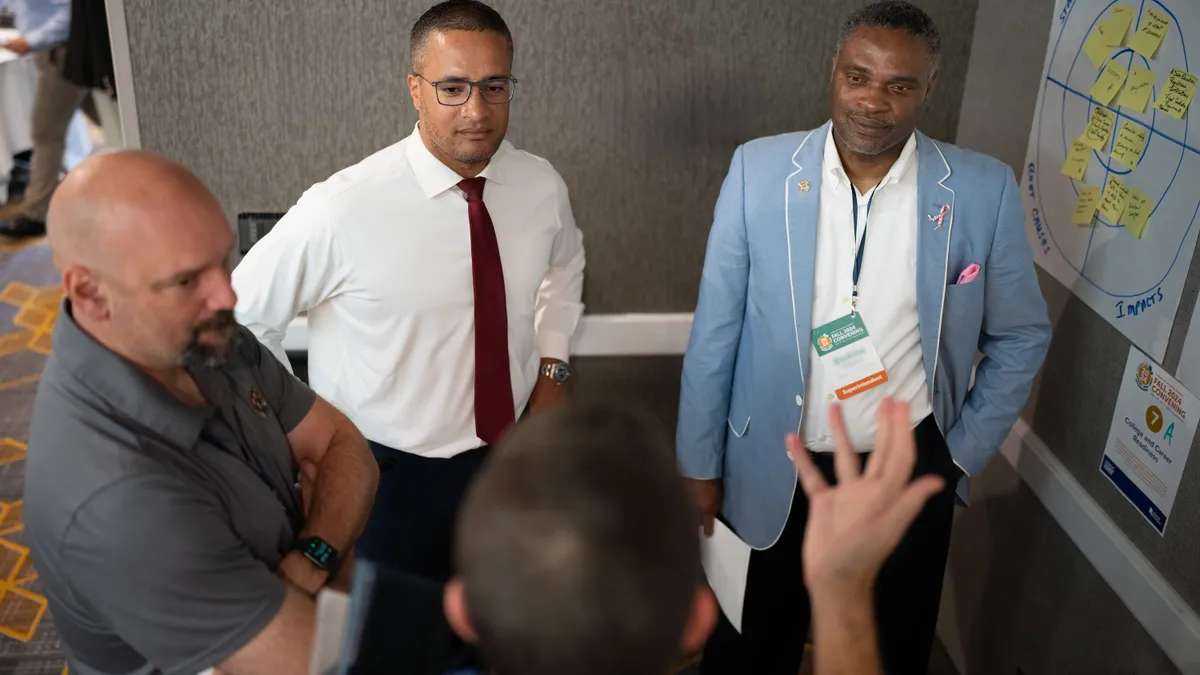Even as today’s world becomes increasingly interconnected, superintendents are seemingly more isolated than ever before. Constant pressure—due to political issues, teacher vacancies, burnout, and more—takes an immense toll. At the time of EAB’s 2022 Voice of the Superintendent Survey, nearly half of superintendents planned to leave their roles within two years.
With so many daily concerns that require immediate, swift attention, superintendents rarely have opportunities to connect with fellow leaders who are in their shoes to envision new approaches for working toward longer-term, systemic change for the education sector at large. This reality poses a significant threat to the advancement of education innovation in our country. If the leaders who are closest to the challenges facing educators, students, families, and community members don’t have time or space to build bold, sector-wide solutions, how can we hope to achieve long-term change?
This question is central to the work of national networks like Digital Promise’s League of Innovative Schools. We know that, when we bring superintendents together for intentional problem-solving, innovative solutions emerge that can pave the way for groundbreaking change. Removing silos between leaders allows superintendents to pool their resources and expertise to address complex issues that may be difficult to solve individually.
We recently brought nearly 100 district leaders—70 superintendents and 30 leaders at various levels—together for collaborative, participant-driven sessions where they leveraged a design-thinking process to dive deeply into one of eight challenges identified by education leaders. They reflected on how the given topic shows up in their unique contexts, unearthed barriers and root causes, and identified partners to bring in for additional expertise or capacity. The result? Collaboratively-generated short- and long-term solutions to topics facing nearly all leaders today.
Three topics emerged as top challenges facing our nation’s schools and systems. Here are our leaders’ initial plans for addressing them.
Adults as Learners: Developing Personalized Learning Pathways for Educators
The national teaching shortage and persistent challenges around recruiting and retaining strong teachers is prevalent across states and district types. One potential, contributing factor toward this, according to our superintendents? “Many adults don’t view themselves as learners, which can get in the way of effective professional learning,” Tom Rooney, superintendent of Lindsay Unified School District in California, reflected. According to Rooney and the fellow leaders in his group, this challenge often arises when there is not “a clear vision from district leadership about what professional learning actually looks like.” The group posited that, if leaders fail to address this issue collectively, there will be even higher levels of dissatisfaction and burnout among educators. The group proposed adopting existing technology and tools to deliver a personalized learning journey to educators at all levels of a system so that “teachers’ entire careers are seen as a professional learning journey.”
College and Career Readiness: Preparing Students for “10 Years Out”
“Some students who graduate don’t have a plan for July, and that’s worrisome,” shared John Tague, superintendent of Franklin West Supervisory Union District in Vermont. Tague and his group reflected on what it looks like to truly prepare students for life after high school with an eye on the future, emerging workforce. “There’s a difference between ‘higher education’ and ‘hiring education’.” Leaders shared that there can often be a disconnect between the education system and industry, a discrepancy which—if not addressed—will only exacerbate equity issues when it comes to economic outcomes for students. The group proposed developing a framework by which districts and education systems can work directly with industry and community partners to jointly advance college and career pathways and skills, including through offerings like dual enrollment. “Success will be measured by whether we are preparing students to be effective communicators and problem solvers [and to pursue] the opportunities of their future.”
Student Mental Health and Well-Being: Leveraging Research and Data
As student needs around mental health continue to grow, many districts struggle to keep up with timely resources that are both vetted and effective. “Multigenerational mental health trends in families can be a huge underlying factor around this topic,” shared Holly Edds, superintendent of Orcutt Union School District in California. Edds and her group collectively agreed that failing to comprehensively address students’ well-being will lead to increased dysregulation and decreased academic outcomes, which can pose ripple effects to the adults in their lives and to the broader community. The group proposed developing a framework that would couple success stories and examples from districts who are effectively addressing these challenges alongside research-backed approaches, and looking at data around chronic absenteeism rates to understand whether these approaches are effective.
Check out other innovative solutions to nuanced challenges—like redesigning high school to meet the changing workforce, making effective, judicious decisions around edtech tools, and centering student voice to boost engagement—advanced by districts in the League of Innovative Schools.
Are you interested in co-creating solutions alongside forward-thinking leaders through the League of Innovative Schools? Sign up to be the first to hear when the League’s next application cycle is live.










